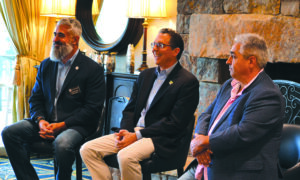NEWSMAKERS BREAKFAST | By Erica Batten and Dave Vieser
A panel discussion hosted by Business Today and Cornelius Today in June focused on the persistent issue of development in a region that takes pride in both its vibrant, forward-looking stance and its small-town atmosphere as well as low property tax rates.
While “smart growth” is a term often bandied about, it’s also one that may be difficult to define, much less achieve. Panelists included Symphony Park developer Jake Palillo, who favors large, concept-based projects over smaller, disparate developments; former Huntersville Mayor John Aneralla, considered by many as the last of a generation of explicitly pro-growth public officials; and Colin Furcht, one of the newcomers to the Cornelius Town Board whose campaign focused on managed growth and livability.
For one hour, they fielded questions from an audience comprised of business and community leaders as well as residents.
During the respectful back-and-forth with the audience, panelists addressed relevant topics such as commercial vs. residential development, traffic and infrastructure woes, the impact of social media on consistent policies around development approvals and denials, and a nation-wide increase in NIMBY-ism.
The Newsmakers Breakfast at The Peninsula Club on Development in a Slow Growth Environment sold out. There was constructive discussion:
Impact Fees: Everything is backwards
Developer Jake Palillo opened his comments with an interesting observation: “They really have everything backwards here in North Carolina. First a project is built, then the infrastructure is improved. It should be the other way around, with improvements built first.”
Of course, that brings up the $64,000 question: Who pays for the improvements? Palillo said impact fees are a very effective way to cover the costs for the needed upgrades. However, impact fees are not permitted in North Carolina. Impact fees are imposed by a branch of local government, such as a town or city, on a new or proposed development to cover the costs of providing public services and upgrading the area infrastructure.
The fees are one way of reducing the impact on local taxpayers, especially in areas experiencing population growth. The Lake Norman area would certainly appear to qualify in that regard, but a legal decision has rendered impact fees illegal in the state. Palillo noted that other states which are experiencing rapid growth, such as Florida, allow impact fees. In the Sunshine State, impact fees are paid by developers as part of the development approval process. The fee is intended to hel3-starter.
Affordable housing: A regional challenge
Any discussion of development will necessarily include affordability. While the area’s proximity to both Charlotte and Lake Norman has turned it into one of the nation’s hottest real estate markets, living in the towns where they work has become increasingly unreachable for many public-sector and other service workers. A regional study released in 2020 by the UNC-Charlotte Urban Institute showed that 80 percent of people who work in North Mecklenburg County live elsewhere, and as home prices continue to rise, so might that number.
 Now, municipalities are starting to implement policies that address affordable housing.
Now, municipalities are starting to implement policies that address affordable housing.
In recent years Cornelius has begun to follow the lead of other North Mecklenburg towns by imposing restrictions on developers no matter where they’re building.
Since 2001, Davidson has required that 12.5 percent of all new housing units be designated as “affordable” or “workforce” housing, meaning that they are priced below a set percentage of the town’s median income. Developers are allowed to pay a fee toward the town’s affordable housing fund in lieu of building actual units.
“There’s a lot of ways to [provide affordable housing] through public-private partnerships,” said Palillo, who is on the affordable housing committee in Huntersville.
Palillo has 20 affordable housing units in the Lagoona Bay development plan.
But Palillo disagrees with policies aimed at affordable housing for public-sector employees. For teachers, police and other emergency personnel, Palillo’s solution is more fundamental.
“Pay them what they deserve to live in the community,” he said.
Recent U.S. Census Bureau data shows the median household income in Cornelius is $95,147.
Mecklenburg County Commissioner Pat Cotham, who attended the breakfast, said tackling workforce housing doesn’t necessarily address the bigger picture of affordability. Cheaper housing is great on paper, but if residents can’t also afford local stores and service providers, it may not be a good long-term strategy.
“This is very complex and it’s deeper and wider than we’re talking about here,” Cotham said.
Social media plays a big role
Further complicating the already complex issue of managing growth is the impact of social media, not just on political campaigns but on decisions that elected officials make on new developments—commercial and residential.
 A 2020 study published in “Management Science” showed that social media presence created a slight advantage in campaign financing that wasn’t shared by incumbents. Conductors of the study concluded that social media allowed newcomers to quickly build the same level of name recognition that incumbents had already accrued.
A 2020 study published in “Management Science” showed that social media presence created a slight advantage in campaign financing that wasn’t shared by incumbents. Conductors of the study concluded that social media allowed newcomers to quickly build the same level of name recognition that incumbents had already accrued.
Unfortunately, unless there is a particularly controversial issue at hand, most residents who do voice their opinion choose to do so online. Projects can be shot down on social media, long before they’re voted on by elected officials.
It may not be Furcht’s preferred means of communicating with constituents, but social media can create a groundswell of activity, particularly when development is unpopular. Hundreds of Huntersville residents turned out to public meetings in April and June to oppose Palillo’s proposed Lagoona Bay project, an $80 million resort development centered on a 10-acre artificial lagoon. Although some residents favor the economic benefits of such a project, those who spoke against it are just a sampling of the opposition that Palillo has faced online to his proposed development. A change.org petition against Lagoona Bay has garnered more than 5,300 signatures. The petition was started by Violet Clarke, whom Palillo is suing, along with another woman, for slander based on comments posted on social media.
Palillo has also responded with changes to the original plans for Lagoona Bay. During a public meeting on June 20, he presented 68 pages of alterations, including plans to address the most-cited grievance: traffic impacts.
“I love social media,” Palillo said, with obvious sarcasm. While social media has created headaches for Palillo as a developer, that’s not his only concern.
“As a resident, I don’t want [the town board] deciding how growth should happen via social media,” he said. “You bring experts in, and you master plan a community based on where life is going. Twenty people pinning places on a map doesn’t work.”
Although a social media presence likely boosted Furcht’s 2021 campaign, it’s not where he looks for guidance when it comes to policy.
 “I’m not a big fan of the keyboard warriors,” he said. “I take much more into consideration when people show up to a meeting or want to sit down and have a cup of coffee. I’m all ears. If you don’t like what’s happening, then say something.”
“I’m not a big fan of the keyboard warriors,” he said. “I take much more into consideration when people show up to a meeting or want to sit down and have a cup of coffee. I’m all ears. If you don’t like what’s happening, then say something.”
Is organic growth enough to sustain town services?
One thing to consider is whether organic growth is sufficient to fund measures meant to maintain the small-town feel, such as those aimed at attracting public-sector workers.
Cornelius’s tax base has grown slowly with the community nearing build-out.
Planning revenue around proposed development is also tricky. Only one fifth of approved projects are ever built.
And even if they are, Furcht added—even if every one of the currently proposed development projects is completed—it would increase tax revenue by just $2 million.
But whether growth is worth it in the long run is another question, one that may be out of the hands of public officials.
“People have the right to sell their land,” Aneralla said.


















